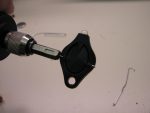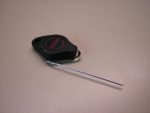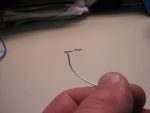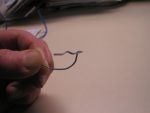Here’s an idea for how to build a tripline-activated infrared light that will illuminate a path or area when triggered. The person passing through will not know they have triggered it, and an observer with a night vision device will be able to see the person better than with only ambient light and without activating their own infrared source/spotlight.
Why set up triplights? The reasons would be to: (a) alert you to the approach of someone at night, (b) to help you identify the approaching person(s), and possibly even (c) to help you target the approaching person if you absolutely, positively identify them as a hostile and they present an immediate threat to you and yours.
- Buy a Photon infrared micro-light: http://www.photonlight.com/led-flashlights/specialty-ir-infrared-led-lights-illuminators/
- Open the back, and remove the battery.
- Estimate where the drill bit needs to enter, right behind the tiny plastic block that the diode wire rests on (on the side between the block and the keyring hole). Use a push pin to start the hole for the drill.
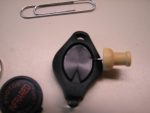
- C-a-r-e-f-u-l-l-y drill into the hole started by the push pin and straight through the light to the other side. (I used a 1/16 drill bit.)
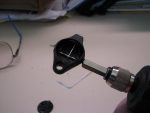
- Bend a big metal paper clip into the shape shown, with a very small bump on the leg to be inserted into the light. Trim off any excess paperclip that sticks out the opposite side of the light. This is your “trigger”.
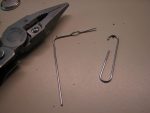
- Put the IR diode wire off to the side of the tiny plastic block, where it will constantly contact the paperclip to be inserted over it. Insert the paperclip and work it through the hole to the other side.
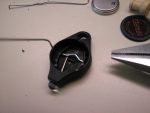
- Replace the battery and back cover, and test. On my first try, the bump on the paperclip was too tall and so the clip couldn’t rotate fully forward, so I adjusted it with my Leatherman. On a second try, the light stayed on all the time and wouldn’t shut off. You’ll have to experiment.
- With the wire in the back/up position, the light is off. With the wire rotated forward, the light comes on and stays on, as long as the wire is in this position. PHOTOS

- Bend the long leg of the paperclip into a smooth curve up, as shown. You may have to adjust the radius of the curve in the field with your fingers. The purpose of the curve is to ensure that the tripline loop you put over the paperclip pushes it fully into the “on” position.
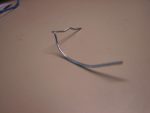
- Note that you can only see a faint red glow in the diode, when it is on. Also note that, contrary to appearances, the amount of light shining out of the LED is quite bright. To avoid injuring your eye, don’t stare into the LED when it’s on.
- Buy a couple of screw-eyes that will fit through the keyring hole in the squeeze light. (These linked work.) The threads should be about an inch long so that you can screw it into bark (or wood/plastic/sheet metal) far enough to tighten against the light and hold it in place.
Use your knife to chip away some of the loose bark to get down to the more solid bark that will hold the screw-eye better. (You could use a little stick through the screw-eye itself if it makes it easier for you to hold and turn.) Give your screw-eyes a shot of flat brown paint so they aren’t so shiny. (Mine are still brass in the photos for visibility.) I prefer not to use a hammer or rock to pound a nail in; it’s just quieter and easier to remove and relocate later.
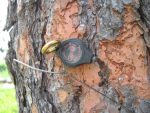
- Keep the paperclip in the up position when mounted. Put a small loop of your tripline over the trigger wire. Tie the loop in advance when you have lots of light; working with tiny line is tough. I recommend not using tripwire (which may be felt when a person contacts it) and also not clear fishing line or “invisible sewing thread” which is thinner but still quite strong, because it still catches the light from a flashlight and glimmers in the dark. (Trust me on this.)
My preference at this point is black sewing thread. It’s still plenty strong enough to activate the IR light or mousetrap (#17, below), and it’s pretty much invisible, even in daylight. It’s inexpensive, so buy several spools!
- Use another screw hook or cup hook below the IR light to redirect the tripline’s pull and height, to ensure that when the tripline is pulled it will pull the paperclip extension all the way down (relative to the light) and completely activate the light.
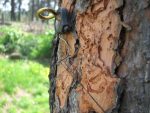
(You might want to scrape the bark away from the tripline loop knot so that it doesn’t catch in the bark!)
- Set up the rest of your tripline by anchoring the other end with another screw-eye. I recommend setting the line height at about waist level. (Remember that wildlife uses paths, even human paths, for convenience too.) If you set it too low you’ll be getting a lot of false alarms. Aim the IR light somewhat horizontally so that it lights up a whole section of the path, not just a small spot in front of the attachment point. If the light is aimed too far downward, the person setting it off will walk out of the illuminating beam too quickly.

- Bonus: I made a tripline tensioner from two metal washers and two pieces of rubber sheeting cut in circles with a hole punched in the middle. Slip this on the screw-eye anchor (opposite the tree that your light is mounted on) and wrap the free end of your tripline around the screw-eye shaft several times, between the two rubber “gaskets”, and then tighten the screw-eye against the tree. This will let you pull the tripline tight and hold it in place.
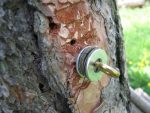
- When you’ve got all your components together and tested, open the back of the IR LED squeeze light and either take out the battery or the paperclip trigger wire, so that the light doesn’t get accidentally activated. Be sure to buy extra batteries. Get them in bulk online, not from your local store where the battery prices are terribly inflated. Put all of your components in a bag or Ziploc to make a kit. Throw a little roll of duct tape in and maybe some 3M double-sided tape and also cheapo fingernail trimmer for cutting your thread or other tripline if you don’t usually carry scissors.
- My thought, as someone with zero military experience and zero experience using this setup to detect intruders (no intruders, so far, in rural Spokane except for four-legged varmints), is to set up both a mousetrap and the IR light side-by-side on the same tree.
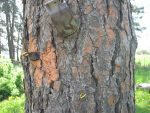
At dawn on your morning checks, you can release the tension on the far end anchor of the tripline to give it slack, then move the tripline loop from the IR light to the mousetrap, for audible daytime monitoring. (Loop it around the mousetrap trigger/catch “spoon”.) Then move it back to the light at dusk. I’m just brainstorming here.
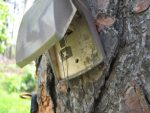
This new type are my favorite mousetraps, because they’re safer to reset. Give them a camo paint job, and drill a big anchor hole for a long-shaft screw-eye in the rear (or take off a corner of the “hammer”/lid). You need to be able to quickly anchor or remove the mousetrap without interfering with its function. I’m sure you’ll figure it out.
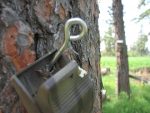
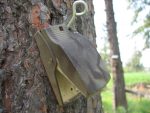 [Editor’s Note: The Snap-E Mouse Traps work similarly to the Victor’s referenced above, but they already have two holes that allow them to be secured to the ground. I’ve used both and found that the Victor quality has changed in the past year or two, so we’ve switched to the Snap-E.]
[Editor’s Note: The Snap-E Mouse Traps work similarly to the Victor’s referenced above, but they already have two holes that allow them to be secured to the ground. I’ve used both and found that the Victor quality has changed in the past year or two, so we’ve switched to the Snap-E.]If you’re not going to switch between IR lights and mousetraps, at least don’t set/activate your IR light until dusk. If someone or something trips it during the day, they’ll just run the battery down. No one will be able to see that the light is on, and the batteries only have about a 12-hour life.
- I hesitate somewhat to mention this, but you could even deploy a “12 gauge Perimeter Alarm System” like this: http://www.americanspecialtyammo.com/Gadgets.html They’re much more expensive per monitoring point than a mousetrap, but if you want to scare the life out of your intruder, this would definitely do the job.
Be aware of the potential for starting a fire, and please do not use these as booby traps. There’s a possibility that curious wildlife or a dog or child could be seriously injured or blinded. Mount it out of their reach, and use a screw eye or nail to redirect the trigger wire pull. Also, realize that even giving them the scare of their life might not deter the really desperate individuals.
Why would you use an audible signal when it will alert the person that (a) they have been detected and that (b) you are somewhere nearby? Well, it might be the best strategy you can manage under the circumstances. At least you will know they are there and approximately where they were when they triggered it. That is still very valuable information.
- Far niftier but more complex and much, much more expensive would be setting up seismic sensors on the paths you want to monitor. These sensors radio an alarm back to their MURS base station when activated. Search SurvivalBlog for “Seismic Intrusion”.
- I should probably mention here that a mid-range option for cost and complexity would be using battery-powered passive infrared motion detectors, originally designed for driveways to detect cars. They may not detect a person wearing heavy winter clothing, unless the detector can “see” the person’s face. (They also don’t detect cars well if they are still cold and haven’t been run for very long.)
We’ve used these for many years now and they continue to work below freezing and even in snow, if you make a little snow-shield cover for the detector. They use batteries, so stock up on batteries or rechargeables, though they get really good battery life. You’ll have to mod them a bit, since the base station sounds an audible alarm you probably don’t want to share with the surrounding forest/area. But they also flash a light, which is good.
There are (or at least were, when I bought mine) at least three different “channels”, so you can actually run at least three at a time, as we do, and still tell them apart. You’ll have to look through the boxes in the store to see what channel each unit works on (there should be a sticker) to be sure you don’t get duplicates.
Label which base station goes with which detector, and you’ll know right where the detection happened. At home you could put one in your RV or camping trailer facing the door, one in your shop or toolbox facing up, one in your car or truck facing the driver seat, et cetera.
- There’s no reason you couldn’t modify a regular white-light LED squeeze light in this same way. You could also go crazy and rig a line to trigger one or two sets of battery-powered white light string lights. I personally like the idea of remotely lighting up the area where an unknown person is, rather than giving away my exact location by activating my weapon light or flashlight.
Never set booby traps that act without human control/input. The person coming down the trail could be a friend or ally or someone in desperate need of your help!
Remember that you can have “false negatives” with tripline alarms! For instance, just because the alarm on the trail you’re monitoring hasn’t gone off, it doesn’t mean there aren’t bad guys closing in on your position. Smart opponents stay off trails when they can or recognize choke points and actively look for triplines. If you think you hear something in your area, or you have a gut feeling that there is someone nearby, check it out even if you haven’t had any trail alarms!
(Note: You can also have “false positives” when a deer or dog or a falling branch sets it off. False positives are a danger, because they cause you to lower your guard thinking, “Oh, that’s just another stupid deer”and ignore alarms.)
It’s a safe bet that most of the people in the groups we’re going to get thrown together with (in spite of our plans!) are not going to have night vision devices. So an IR squeeze light on a tripline is going to have limited but possibly critical application. On the other hand, most of your people are going to need white light illumination at some point in a confrontation at night, so definitely have a plan for that! (Also, train your people to avoid white-light “misfires”– accidental weapon light or flashlight activation that dangerously gives away your position.)
M-a-y-b-e all this will be unnecessary. Maybe it’s overkill, but maybe these ideas are options you’ll wish you had at some point in the future. That one successful detection of persons coming through the woods (or desert or alley) in your direction could be the difference between life and death for you, your family, and your team.
Yet, remember this: Our trust is not in technology or tools. Our confidence and hope are not in anything we do or have or know, even though we keep a watchful eye and our guard up. We make the time to stop and wait on God. These intangibles, His peace, His patience, His love, His guidance, His strength, His hope– those are what will give us the edge to survive the people who mean to do us harm, along with the equipment we’ve wisely purchased.
We know we will screw up if we go off half-cocked, if we get all wound up, worried, and panicked when something starts to go wrong. We know we must wait on God. Must. Wait. How else are we going to hear his still, small voice in the storm, directing and protecting, calming, and focusing us? And, if you’re not walking with Him now, how do you expect to walk with Him then?
“This is the way, walk in it,”
Whenever you turn to the right hand
Or whenever you turn to the left.” (Isaiah 30:21)And lean not on your own understanding;
In all your ways acknowledge Him,
And He shall direct your paths.” (Proverbs 3:5-6)
Trust God. Be Prepared. We can do both.










